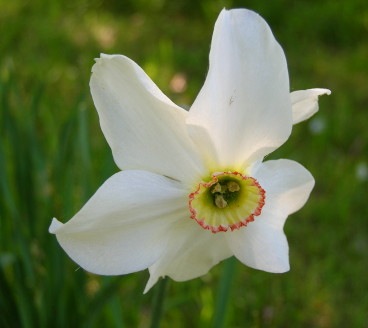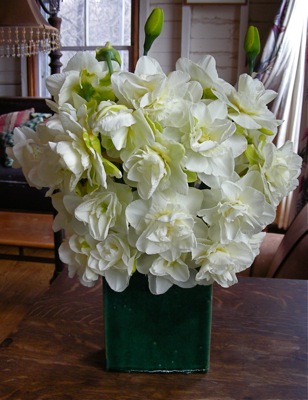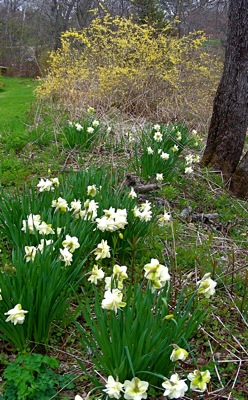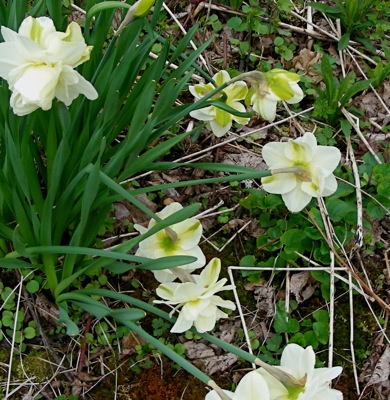Organic Tulip Bulbs for Fall Planting
It had to happen sooner or later, and sure enough here they are, catchily called Ecotulips.
As usual with newly-introduced organic versions of things, there still isn’t much selection and prices are a bit higher than for the conventional kind, but if you’d like to buy certified organic tulip bulbs, lovingly grown in Holland by an experienced bulb farmer, at least you’ve got the option.

a poeticus narcissus, probably 'Pheasant's Eye'
So if the title is Organic Tulips, why is the picture of a narcissus? Partly because I’ve already gone into how to grow tulips, and partly because there’s more to environmental responsibility than simply buying organic and calling it a day.
For one thing, there’s the mileage question; it’s much easier to find (sort-of) locally grown daffodils than locally grown tulips.
For another, daffodils are much easier to save and reuse. Tulips can come back more frequently than they’re given credit for, but they don’t come back the way daffodils do and they certainly don’t multiply the way daffodils do.
Also: deer. They eat tulips; they don’t eat daffodils.
Choosing daffodils

This particular bunch is 'Obdam,' which I got some years ago from Brent and Becky's
- It’s even harder than choosing tulips, but checking the description for “naturalize” eliminates a lot of otherwise tempting contenders. Naturalize is narcissusspeak for ” likely to come back and multiply” and its omission is a warning that the beauty in question may not be an eager grower.
The other thing to keep in mind is use in the landscape.

Here are the Obdams in situ, looking rather patchy because they’re much earlier than all the others.
Bloom times matter, in other words. So does weather resistance. Look closely and you also see the problem with double daffodils: heavy heads.

It’s best to pick them when they’re about to burst from bud and even then don’t hold the bunch of stems at the base.
Finding local daffodils
I said “sorta” back there because you can’t always find a friend with clumps to divide and there are only so many commercial growers. The American Daffodil Society has a list of US growers, all of whom are specialists of one sort or another (with prices to match) and Old House Gardens’ advanced search function includes the category: American Grown.
Admittedly, by the time they’ve gone to Old House and then to you they might as well have come from Turkey, original home of most of them, but at least you’ll learn which states have growers and can take it from there.
The category “organic” doesn’t appear to exist, at Old House or anywhere else. But David Burdick, whose company is correctly named Daffodils and More, says on his website: “ We can’t state that what we sell are organically grown flower bulbs, as we would need official certification to do so, but once again we feel it’s time to let people know the treatments we use for any insect and fungal problems are all acceptable in organic programs. So far, only food items produced this way seem able to command the attention of consumers and promoters of the cause. Here’s hoping that ornamental plants grown in a responsible way can garner the same respect.”
Here’s hoping he isn’t alone and that I will soon – Please; I’d love it! – hear from others who can make the same claim.
The poeticus photo is by Kristi Niedermann and Brent and Becky’s website is here.















Leslie didn’t mention this: she migh not even know, but in May as I scour the countryside for Morels, I often find clumps of Daffodils scattered here and there in areas where older settlements once stood. Usually there are few blooms, due I suspect to the overcrowding of the vegetative clump, but brought home and divided they seem to take quite well. From where they come you can bet your bottom dollar that they are older varieties, deer resistant, hardy as all get out, and grown without chemical contaminants.
When I liberate a clump I always return a few to the site from which the freed fronds have come. True perennials and a gift passed on to the traveller next spring when the thinned stand blooms anew.
Leslie does know, in fact she raises her eyebrows every time he comes home with some liberated treasure. He usually finds them in the woods, however, where they really don’t get enough light to bloom well even when divided; every good thing he says about them is true and being older varieties they have a subtle delicacy missing from many newer introductions.